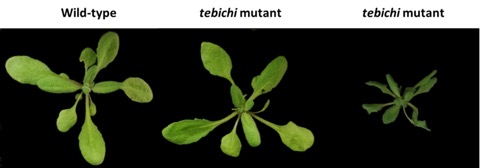TPJ article: Solving the theta enigma: Polymerase Ɵ-deficiency causes developmental defects
Solving the theta enigma: Polymerase Ɵ-deficiency causes developmental defects
The plant DNA polymerase theta is essential for the repair of replication‐associated DNA damage
Nisa, M., Bergis, C., Pedroza‐Garcia, J.‐A., Drouin‐Wahbi, J., Mazubert, C., Bergounioux, C., Benhamed, M. and Raynaud, C.
https://onlinelibrary.wiley.com/doi/full/10.1111/tpj.15295

Figure. Representative phenotypes observed in homozygous tebichi (teb) mutants. Most of the teb mutant plants developed like wild-type plants (middle), whereas 10-15% showed severe developmental defects (right). Picture from Nisa et al., 2021.
Via air, soil, and water, plants are continuously exposed to DNA-damaging agents. For example, UV radiation from the sun generates DNA lesions, and multiple bacteria and fungi can induce double-strand breaks. But DNA damage is not only caused by the environment. During DNA replication, mistakes occasionally occur, for example when nucleotides pair incorrectly. Because DNA damage can lead to genome instability, which has adverse effects on growth and development, plants evolved a sophisticated mechanism: when DNA damage is sensed, the cell cycle is arrested, and if possible, the DNA gets repaired. Mutant plants deficient in proteins in the DNA repair pathway are hypersensitive to DNA-damaging agents. However, they generally develop in a normal way. Polymerase theta (Pol Ɵ), an enzyme involved in the repair of double-strand breaks and the bypass of DNA lesions during replication, seems to be a remarkable exception to this rule. tebichi (teb) mutants, that are deficient for Pol Ɵ, were reported to show severe developmental defects, including reduced growth, deformed leaves, and disorganized root. However, the role of Pol Ɵ is controversial, as another research group did not observe severe developmental defects in teb mutants.
A group of researchers from the Université de Paris, France, decided to carefully re-examine the Arabidopsis teb mutants. In issue 106:5 of the plant journal, they report their findings. When the authors first grew the mutant plants, they noticed that most of them developed like wild type, but ~10-15 % showed the severe developmental phenotype that corresponded with the previously described phenotype (Figure). Corresponding author Cécile Raynaud explains that at first, she assumed that the mutants were hemizygous. However, genotyping showed that all plants were homozygous for the teb mutation and none of the mutants produced full-length TEB mRNA. The authors tried to find other explanations for the distribution of phenotypes, but they could not. Mutant plants that showed the developmental phenotype did not accumulate more DNA damage than mutants that looked like wild-type plants, and there was no difference in the expression levels of genes that are involved in the DNA damage response pathway. Moreover, the progeny from mutants that looked like the wild-type and from mutants with severe developmental defects showed the same distribution of phenotypes as the parental plants, indicating that the developmental defects are not due to heritable mutations.
The authors wondered if they could increase the proportion of teb mutants that displays the phenotype. Pol Ɵ is proposed to play a key role in replicating cells, and the authors reasoned that increasing replicative stress might affect the distribution of the phenotype. To test this, they treated plants with hydroxyurea, which causes double-stranded breaks in dividing cells. Indeed, treatment of teb mutant plants with this compound increased the proportion of plants with severe developmental defects to almost 30%, whereas treatment of wild-type plants slowed growth, but no developmental defects were observed. Hence, it appears that the phenotype in teb mutants is caused by deficiency of Pol Ɵ in replicating cells.
The authors reasoned that the differences between their observations and previous reports could stem from different intensities of basal replicative stress between growth conditions in the different laboratories. To test this hypothesis, they subjected the teb mutants to different abiotic stresses: high light intensity, salt treatment and heat. Indeed, high light and high salt stress increased the proportion of plants with the developmental phenotype. Thus, environmental conditions affect the distribution of the phenotype and might explain why different labs made different observations.
These results put an end to the controversy around teb mutants: Pol Ɵ-deficient Arabidopsis plants do indeed show severe developmental defects. Cécile Raynaud explains that in the future, she would like to understand how the deficiency of Pol Ɵ leads to developmental defects. Moreover, she wants to solve why the developmental phenotype appears irregularly. It might help if they figure out what caused the discrepancies between the different laboratories, because for now, the exact reason remains enigmatic.
Leonie Verhage, Research Highlights Editor
